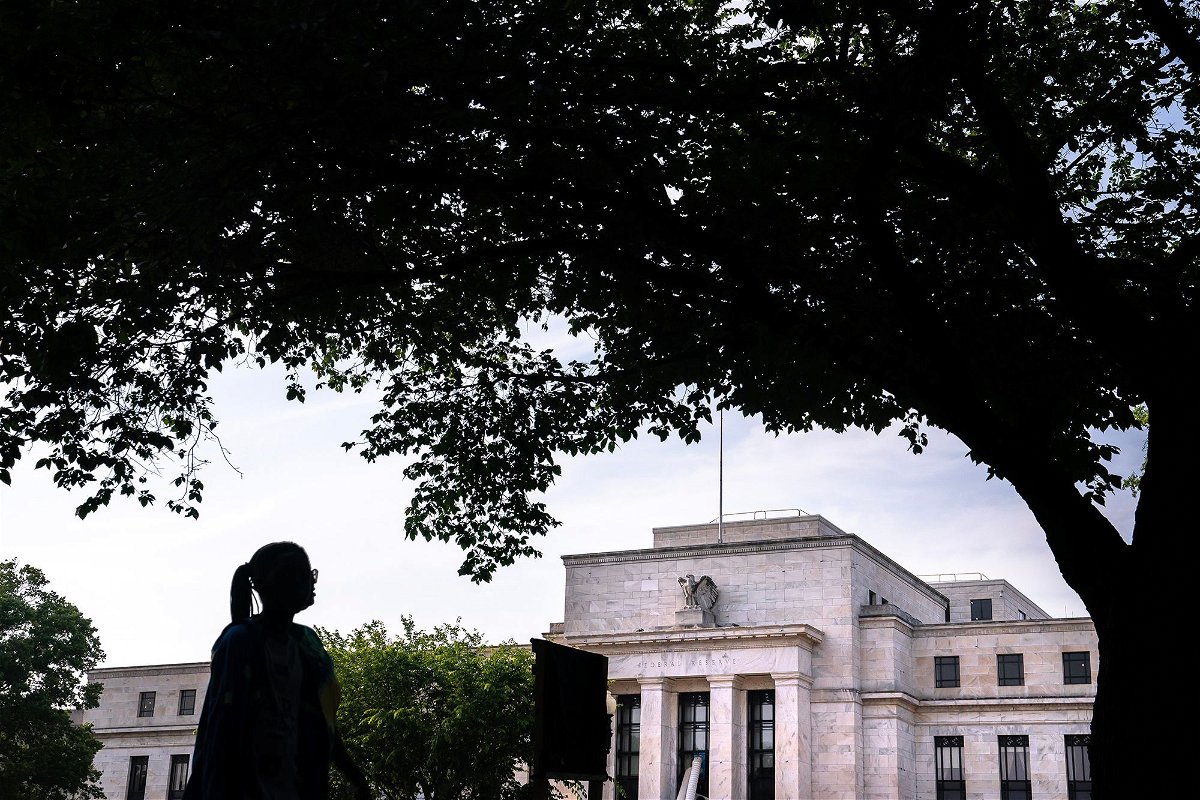Fed’s stress test results show banks’ strength in light of the recent crisis

A pedestrian passes the Marriner S. Eccles Federal Reserve building in Washington
By Elisabeth Buchwald, CNN
New York (CNN) — The largest US banks have sufficient safeguards in place to weather a severe recession while continuing lending to households and businesses, the Federal Reserve said Wednesday in its annual bank resilience test.
The Fed’s stress tests carried extra weight this year after the collapse of three US banks sent shockwaves through the banking system.
All 23 banks required to take the Fed’s exam fared better this year compared to last year, despite being subjected to a worst-case scenario that was even more painful than last year’s.
Like last year, banks tested remained above their minimum capital requirements in the test’s worst-case scenario but would stand to lose a collective $541 billion. Capital ratios would decline by 2.3% to 10.1%, more than double the requirement.
Last year’s tests, which included smaller banks that are tested every other year, found that those tested would lose $612 billion and capital ratios would decline by 2.7% to 9.7%.
“Today’s results confirm that the banking system remains strong and resilient,” Michael Barr, the Fed’s vice chair for supervision, said in a statement.
“At the same time, this stress test is only one way to measure that strength,” he added. “We should remain humble about how risks can arise, and continue our work to ensure that banks are resilient to a range of economic scenarios, market shocks, and other stresses.”
Barr, who oversaw the Fed’s autopsy report on failed Silicon Valley Bank, previously said he’s working on updating the Fed’s stress-testing models based on the lessons he’s learned from the recent bank failures.
2023 stress test scenario
The tests, designed to see how well banks perform in a high-stress climate, were developed before the crisis unfolded. The tests weren’t updated to incorporate factors like rising interest rate risk that played a significant role in the demise of the three banks.
It would have been prudent for the Fed to update the scenarios, given what they’ve learned about the nature of the recent bank failures, said João Granja, an accounting professor at the University of Chicago Booth School of Business who specializes in banking regulation.
Silicon Valley Bank, Signature Bank and First Republic Bank failed in part because they weren’t prepared for an environment with rising interest rates coupled with a shrinking deposit base. Yet the scenarios for this year’s tests assume interest rates will fall, which is generally the case in a recession.
Still, the stress tests produced meaningful results, said Francisco Covas, head of research at the Bank Policy Institute, a trade group representing many of the country’s largest banks. That’s because this year’s “severely adverse” scenario is already so extreme, he said.
“A realistically framed scenario featuring rising interest rates, coupled with less marked economic and asset price declines, would lead to less capital depletion than the existing scenario, adding little new insight to the overall results,” Covas said in a statement on Wednesday.
Under this year’s scenario, or hypothetical recession condition, the unemployment rate rose by 6.5 percentage points over the course of two years. In last year’s scenario, the unemployment rate rose by 5.8 percentage points.
This year’s scenario also features a more extreme and rapid decline in home prices of 38% versus last year’s 28.5% decline. But no changes were made with regard to commercial real estate, an increasingly troublesome area for banks, as many offices remain vacant. Like last year, the scenario assumes a 40% plunge in commercial real estate prices.
The banks in this year’s test hold roughly 20% of the office and downtown commercial real estate loans held by banks, according to the Fed. The hypothetical $100 billion losses stemming from real estate troubles tripled the levels reached during the 2008 financial crisis, the Fed said.
While all banks passed the tests, their performance varied significantly under the severe recession scenario. Notably, mid-sized banks including Capital One and Citizens Bank experienced steeper losses and took bigger hits to their capital ratios compared to the average across all 23 banks.
Performance in the stress tests varied by bank
While all banks passed the tests, their performance varied significantly under the severe recession scenario. Notably, many mid-sized banks experienced steeper losses and took bigger hits to their capital ratios compared to the average across all 23 banks.
Capital One suffered the biggest loan loss rate of 14.7%. The stock was down more than 1% in after-hours trading following the stress test results. The bank did not immediately respond to CNN’s request for comment on the stress tests.
Meanwhile, Charles Schwab had the smallest loan loss rate of 1.3%, and it had the highest capital buffer. The stock was up over 2% in after-hours trading.
The KBW Nasdaq Bank Index, which tracks the performance of 24 US banks, moved slightly lower Wednesday evening.
Additionally, banks with large trading operations were tested against a global market shock component that stresses their trading, private equity, and certain other fair-valued positions,” according to the Fed’s February report detailing the 2023 stress test scenarios. Almost all of those banks were also be tested against “the default of their largest counterparty.”
And for the first time, US banks deemed systemically important globally — aka “too big to fail” — will faced an additional “exploratory market shock” that poses a different set of risks than the global market shock component.
Wells Fargo was the only bank that experienced higher losses under the exploratory market shock than the global market shock. The results from the exploratory component won’t be used to set banks’ capital requirements.
Wells Fargo’s stock rose more than 2% in after-hours trading on Wednesday.
These firm-specific results could “give us light into which banks could experience more stress [in a recession],” said Granja.
The fact that no bank failed the stress tests doesn’t mean “these stress tests are not useful,” or the tests were too easy, Covas, a former Fed economist who developed some of the central bank’s early stress tests, said. Ultimately the tests are meant to determine if banks are well-capitalized relative to the risks they’re taking on.
“You really don’t need a stress test to figure out that SVB had some significant issues,” he added.
Banks are expected to announce updated stock buyback and dividend plans based on Wednesday’s results after markets close on Friday.
The-CNN-Wire
™ & © 2023 Cable News Network, Inc., a Warner Bros. Discovery Company. All rights reserved.



